ECO100 Assignment: In-depth Analysis of Economic Theories and Models
VerifiedAdded on 2023/04/21
|14
|1837
|431
Homework Assignment
AI Summary
This assignment provides a comprehensive analysis of fundamental economic concepts. It begins with an exploration of the Production Possibility Frontier (PPF), illustrating trade-offs and efficient production levels, along with its assumptions and properties. The assignment then delves into market dynamics, examining total revenue tests and demand elasticity, calculating equilibrium points, and analyzing consumer and producer surpluses under various price scenarios and government interventions like quantity restrictions. Finally, the assignment addresses the impact of online video rentals on the in-store movie industry, exploring demand shifts, price elasticity, and cross-price elasticity of demand, providing a detailed understanding of how market changes and substitute goods influence economic outcomes. This homework assignment offers detailed solutions to complex economic problems.
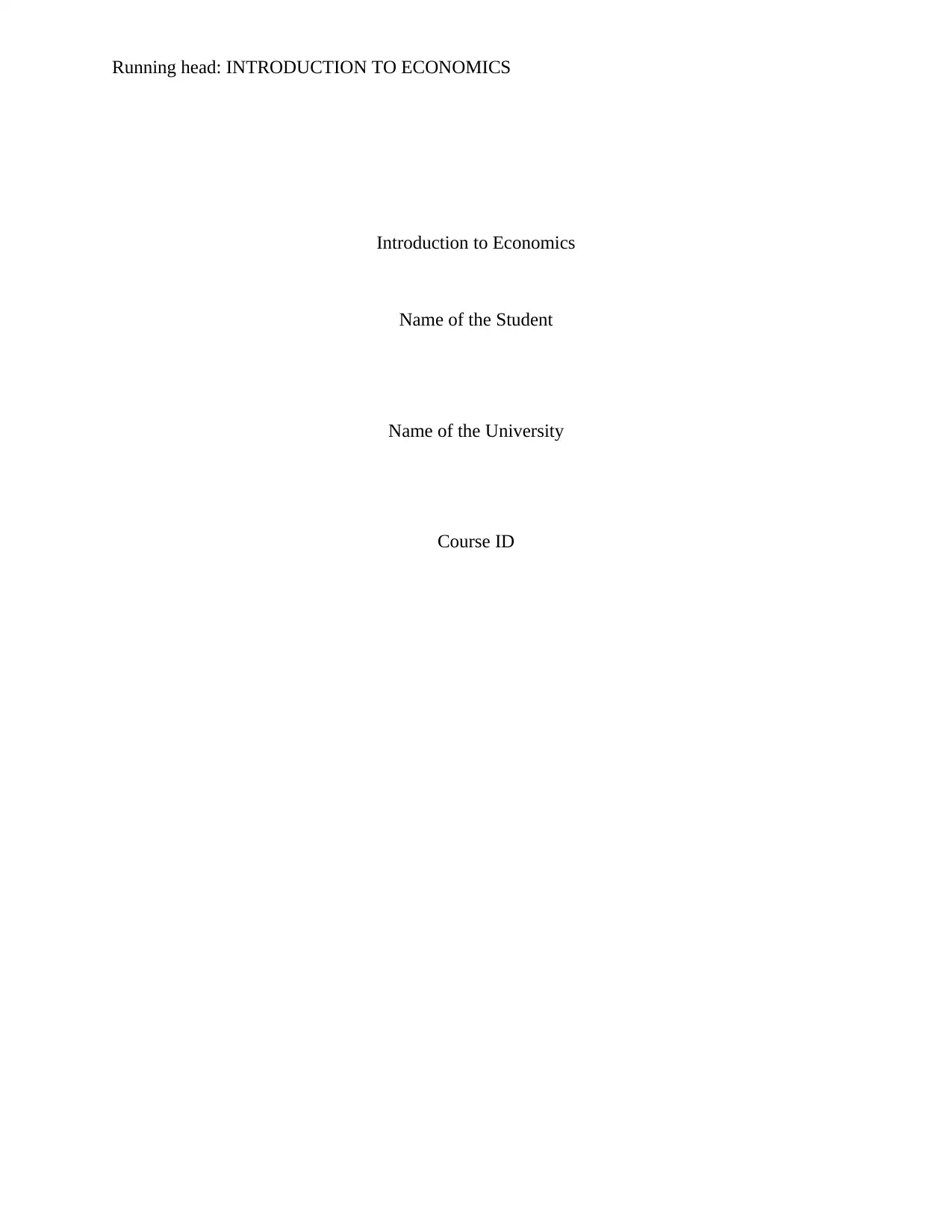
Running head: INTRODUCTION TO ECONOMICS
Introduction to Economics
Name of the Student
Name of the University
Course ID
Introduction to Economics
Name of the Student
Name of the University
Course ID
Paraphrase This Document
Need a fresh take? Get an instant paraphrase of this document with our AI Paraphraser
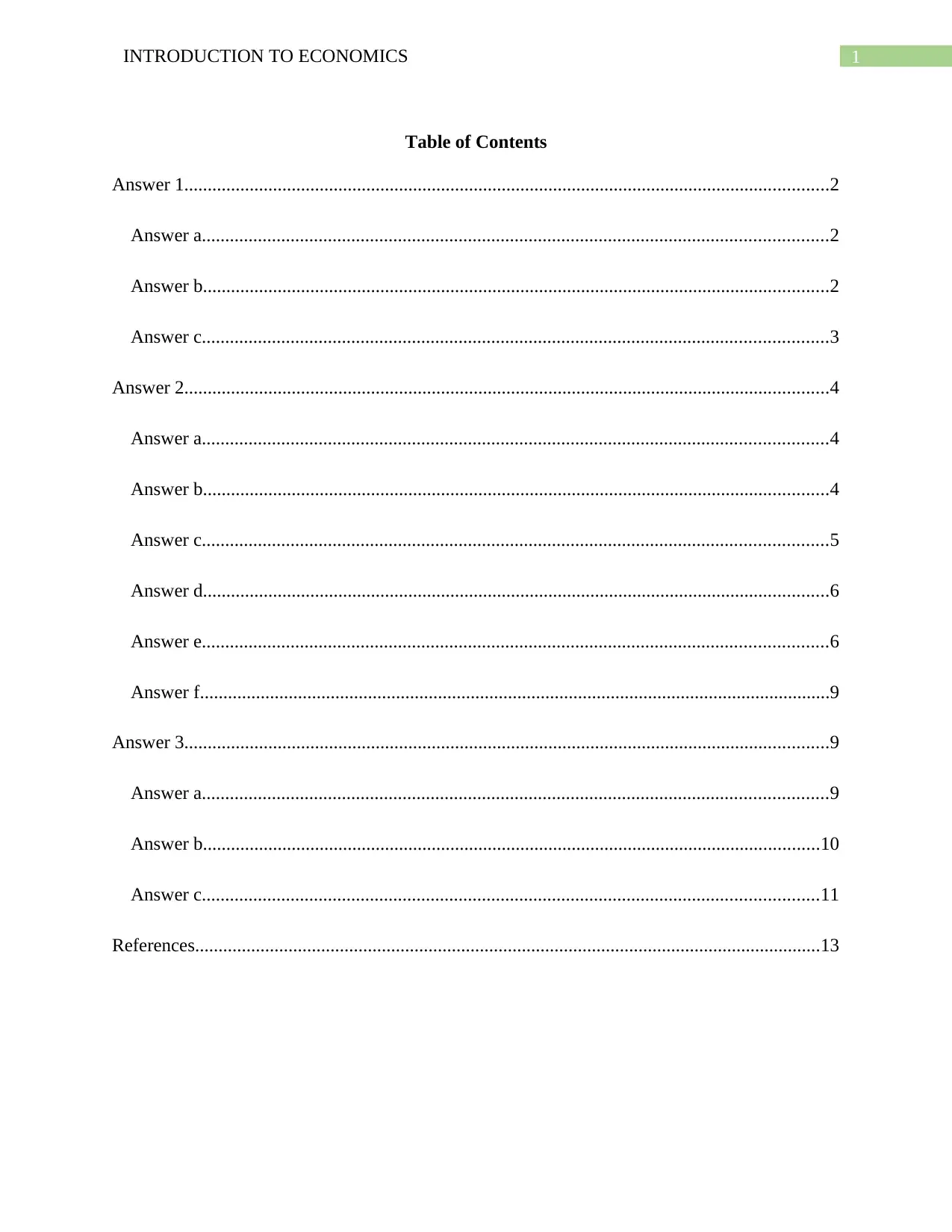
1INTRODUCTION TO ECONOMICS
Table of Contents
Answer 1..........................................................................................................................................2
Answer a......................................................................................................................................2
Answer b......................................................................................................................................2
Answer c......................................................................................................................................3
Answer 2..........................................................................................................................................4
Answer a......................................................................................................................................4
Answer b......................................................................................................................................4
Answer c......................................................................................................................................5
Answer d......................................................................................................................................6
Answer e......................................................................................................................................6
Answer f.......................................................................................................................................9
Answer 3..........................................................................................................................................9
Answer a......................................................................................................................................9
Answer b....................................................................................................................................10
Answer c....................................................................................................................................11
References......................................................................................................................................13
Table of Contents
Answer 1..........................................................................................................................................2
Answer a......................................................................................................................................2
Answer b......................................................................................................................................2
Answer c......................................................................................................................................3
Answer 2..........................................................................................................................................4
Answer a......................................................................................................................................4
Answer b......................................................................................................................................4
Answer c......................................................................................................................................5
Answer d......................................................................................................................................6
Answer e......................................................................................................................................6
Answer f.......................................................................................................................................9
Answer 3..........................................................................................................................................9
Answer a......................................................................................................................................9
Answer b....................................................................................................................................10
Answer c....................................................................................................................................11
References......................................................................................................................................13
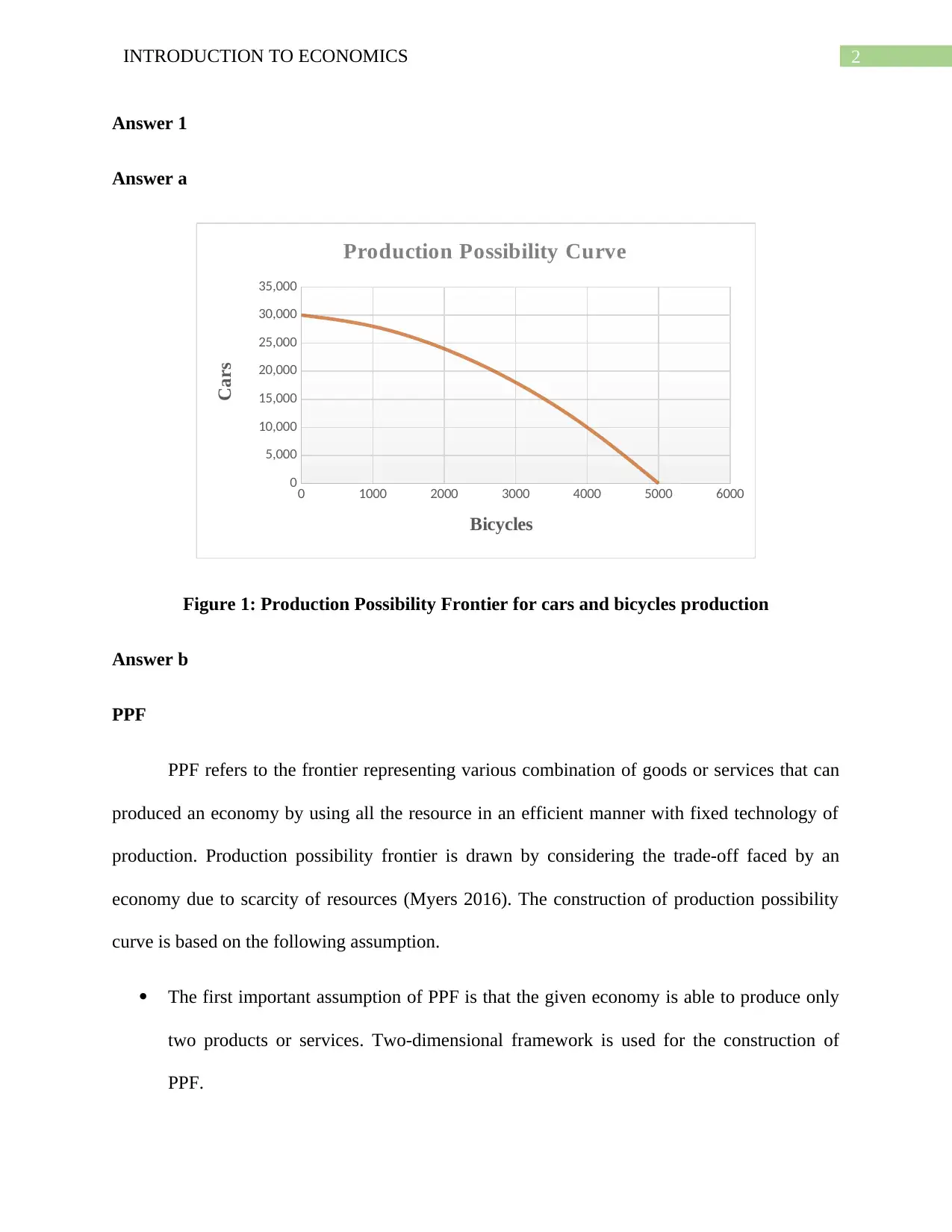
2INTRODUCTION TO ECONOMICS
Answer 1
Answer a
0 1000 2000 3000 4000 5000 6000
0
5,000
10,000
15,000
20,000
25,000
30,000
35,000
Production Possibility Curve
Bicycles
Cars
Figure 1: Production Possibility Frontier for cars and bicycles production
Answer b
PPF
PPF refers to the frontier representing various combination of goods or services that can
produced an economy by using all the resource in an efficient manner with fixed technology of
production. Production possibility frontier is drawn by considering the trade-off faced by an
economy due to scarcity of resources (Myers 2016). The construction of production possibility
curve is based on the following assumption.
The first important assumption of PPF is that the given economy is able to produce only
two products or services. Two-dimensional framework is used for the construction of
PPF.
Answer 1
Answer a
0 1000 2000 3000 4000 5000 6000
0
5,000
10,000
15,000
20,000
25,000
30,000
35,000
Production Possibility Curve
Bicycles
Cars
Figure 1: Production Possibility Frontier for cars and bicycles production
Answer b
PPF
PPF refers to the frontier representing various combination of goods or services that can
produced an economy by using all the resource in an efficient manner with fixed technology of
production. Production possibility frontier is drawn by considering the trade-off faced by an
economy due to scarcity of resources (Myers 2016). The construction of production possibility
curve is based on the following assumption.
The first important assumption of PPF is that the given economy is able to produce only
two products or services. Two-dimensional framework is used for the construction of
PPF.
⊘ This is a preview!⊘
Do you want full access?
Subscribe today to unlock all pages.

Trusted by 1+ million students worldwide

3INTRODUCTION TO ECONOMICS
PPF is based on the assumption that an economy has fixed resources. Because of the
fixed resources, the economy faces the problem of scarcity. This addresses the possible
change in the economic growth following any change in resources.
The next vital assumption is that the economy possesses fixed technology. Every
economy has a fixed level of knowledge about production or technology. PPF is
constructed depending on ability of the economy to produce two goods with this fixed
technology.
Another assumption behind PPF is that the economy uses all of its resources in a
technically efficient manner (Stiglitz and Rosengard 2015). That means, in the production
process there is no loss of resources. Hence, the economy attains maximum feasible
output.
PPF has the following properties
PPF slopes downward. The negative slope of PFF implies increasing production of one
good means reduction in production of some other. This is known as opportunity cost of
production.
Along the PPF, the marginal rate of transformation between the two good is increasing in
nature (Green 2015). This implies as the economy choses to produce more nits of one
good it has to forgo more and more of the others.
Following increasing marginal rate of transformation or increasing opportunity cost of
resources, PPF bowed outward or shaped concave to the origin.
Any point on the PPF shows feasible and efficient level of production. Points inside the
PPF are inefficient.
Answer c
PPF is based on the assumption that an economy has fixed resources. Because of the
fixed resources, the economy faces the problem of scarcity. This addresses the possible
change in the economic growth following any change in resources.
The next vital assumption is that the economy possesses fixed technology. Every
economy has a fixed level of knowledge about production or technology. PPF is
constructed depending on ability of the economy to produce two goods with this fixed
technology.
Another assumption behind PPF is that the economy uses all of its resources in a
technically efficient manner (Stiglitz and Rosengard 2015). That means, in the production
process there is no loss of resources. Hence, the economy attains maximum feasible
output.
PPF has the following properties
PPF slopes downward. The negative slope of PFF implies increasing production of one
good means reduction in production of some other. This is known as opportunity cost of
production.
Along the PPF, the marginal rate of transformation between the two good is increasing in
nature (Green 2015). This implies as the economy choses to produce more nits of one
good it has to forgo more and more of the others.
Following increasing marginal rate of transformation or increasing opportunity cost of
resources, PPF bowed outward or shaped concave to the origin.
Any point on the PPF shows feasible and efficient level of production. Points inside the
PPF are inefficient.
Answer c
Paraphrase This Document
Need a fresh take? Get an instant paraphrase of this document with our AI Paraphraser
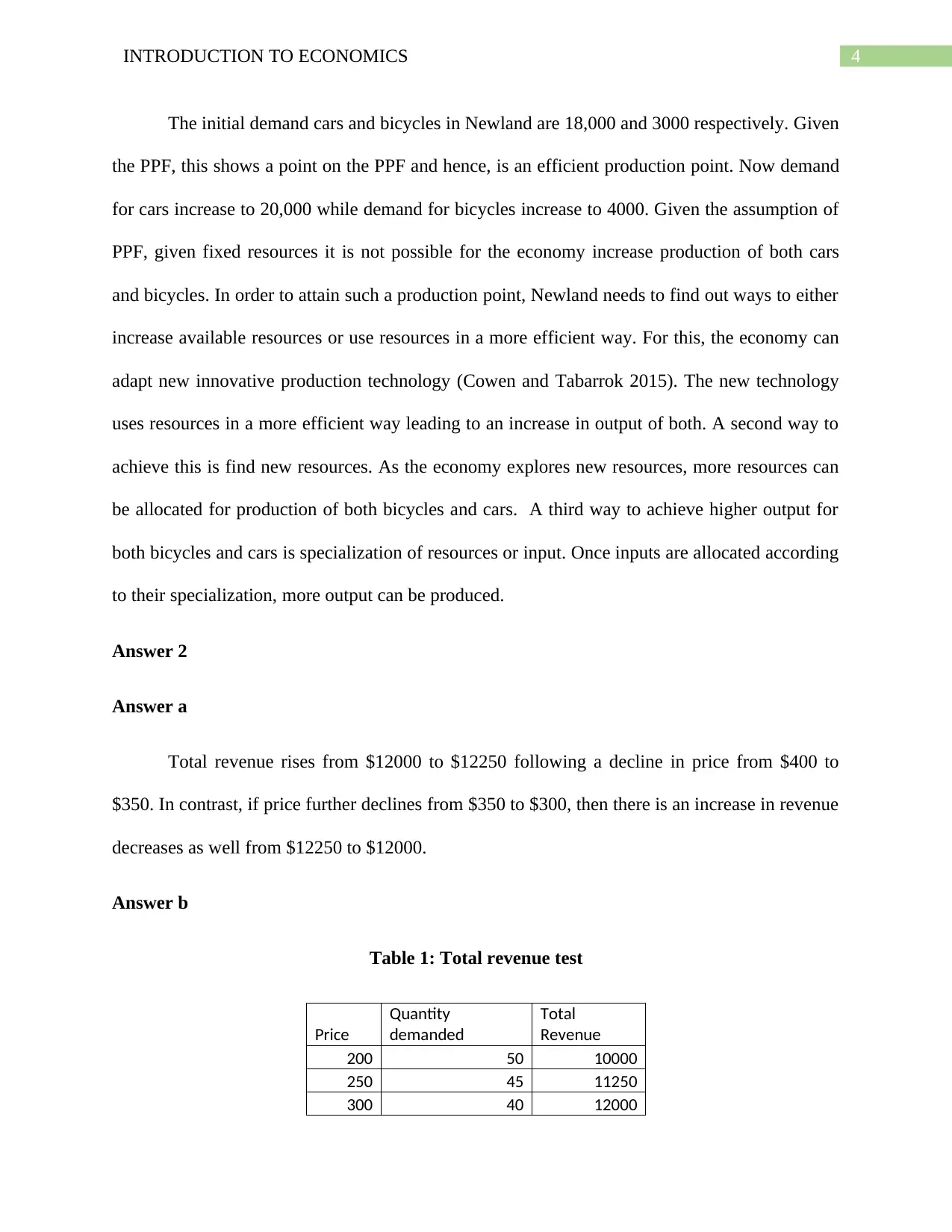
4INTRODUCTION TO ECONOMICS
The initial demand cars and bicycles in Newland are 18,000 and 3000 respectively. Given
the PPF, this shows a point on the PPF and hence, is an efficient production point. Now demand
for cars increase to 20,000 while demand for bicycles increase to 4000. Given the assumption of
PPF, given fixed resources it is not possible for the economy increase production of both cars
and bicycles. In order to attain such a production point, Newland needs to find out ways to either
increase available resources or use resources in a more efficient way. For this, the economy can
adapt new innovative production technology (Cowen and Tabarrok 2015). The new technology
uses resources in a more efficient way leading to an increase in output of both. A second way to
achieve this is find new resources. As the economy explores new resources, more resources can
be allocated for production of both bicycles and cars. A third way to achieve higher output for
both bicycles and cars is specialization of resources or input. Once inputs are allocated according
to their specialization, more output can be produced.
Answer 2
Answer a
Total revenue rises from $12000 to $12250 following a decline in price from $400 to
$350. In contrast, if price further declines from $350 to $300, then there is an increase in revenue
decreases as well from $12250 to $12000.
Answer b
Table 1: Total revenue test
Price
Quantity
demanded
Total
Revenue
200 50 10000
250 45 11250
300 40 12000
The initial demand cars and bicycles in Newland are 18,000 and 3000 respectively. Given
the PPF, this shows a point on the PPF and hence, is an efficient production point. Now demand
for cars increase to 20,000 while demand for bicycles increase to 4000. Given the assumption of
PPF, given fixed resources it is not possible for the economy increase production of both cars
and bicycles. In order to attain such a production point, Newland needs to find out ways to either
increase available resources or use resources in a more efficient way. For this, the economy can
adapt new innovative production technology (Cowen and Tabarrok 2015). The new technology
uses resources in a more efficient way leading to an increase in output of both. A second way to
achieve this is find new resources. As the economy explores new resources, more resources can
be allocated for production of both bicycles and cars. A third way to achieve higher output for
both bicycles and cars is specialization of resources or input. Once inputs are allocated according
to their specialization, more output can be produced.
Answer 2
Answer a
Total revenue rises from $12000 to $12250 following a decline in price from $400 to
$350. In contrast, if price further declines from $350 to $300, then there is an increase in revenue
decreases as well from $12250 to $12000.
Answer b
Table 1: Total revenue test
Price
Quantity
demanded
Total
Revenue
200 50 10000
250 45 11250
300 40 12000
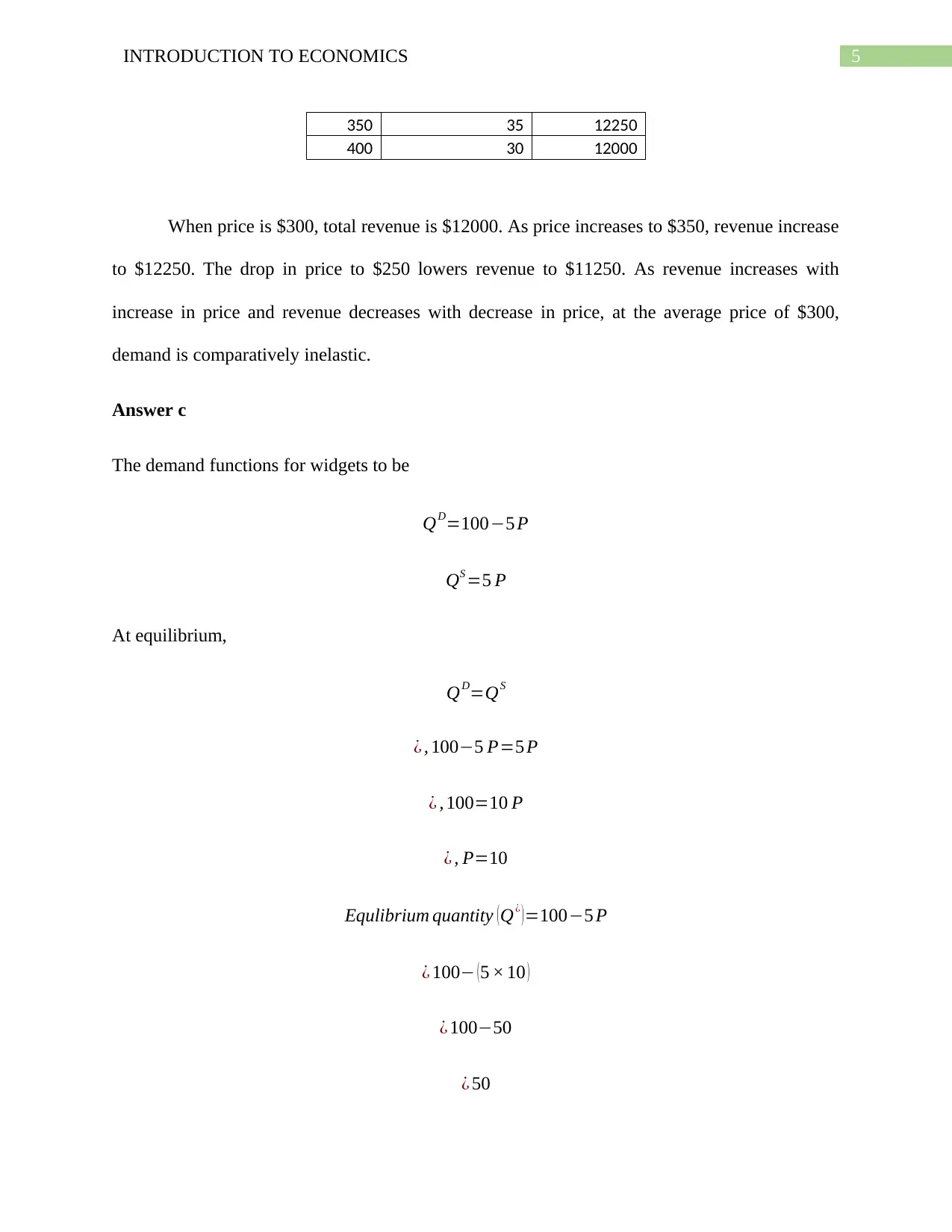
5INTRODUCTION TO ECONOMICS
350 35 12250
400 30 12000
When price is $300, total revenue is $12000. As price increases to $350, revenue increase
to $12250. The drop in price to $250 lowers revenue to $11250. As revenue increases with
increase in price and revenue decreases with decrease in price, at the average price of $300,
demand is comparatively inelastic.
Answer c
The demand functions for widgets to be
QD=100−5 P
QS =5 P
At equilibrium,
QD=QS
¿ , 100−5 P=5 P
¿ , 100=10 P
¿ , P=10
Equlibrium quantity (Q¿ )=100−5 P
¿ 100− (5 × 10 )
¿ 100−50
¿ 50
350 35 12250
400 30 12000
When price is $300, total revenue is $12000. As price increases to $350, revenue increase
to $12250. The drop in price to $250 lowers revenue to $11250. As revenue increases with
increase in price and revenue decreases with decrease in price, at the average price of $300,
demand is comparatively inelastic.
Answer c
The demand functions for widgets to be
QD=100−5 P
QS =5 P
At equilibrium,
QD=QS
¿ , 100−5 P=5 P
¿ , 100=10 P
¿ , P=10
Equlibrium quantity (Q¿ )=100−5 P
¿ 100− (5 × 10 )
¿ 100−50
¿ 50
⊘ This is a preview!⊘
Do you want full access?
Subscribe today to unlock all pages.

Trusted by 1+ million students worldwide
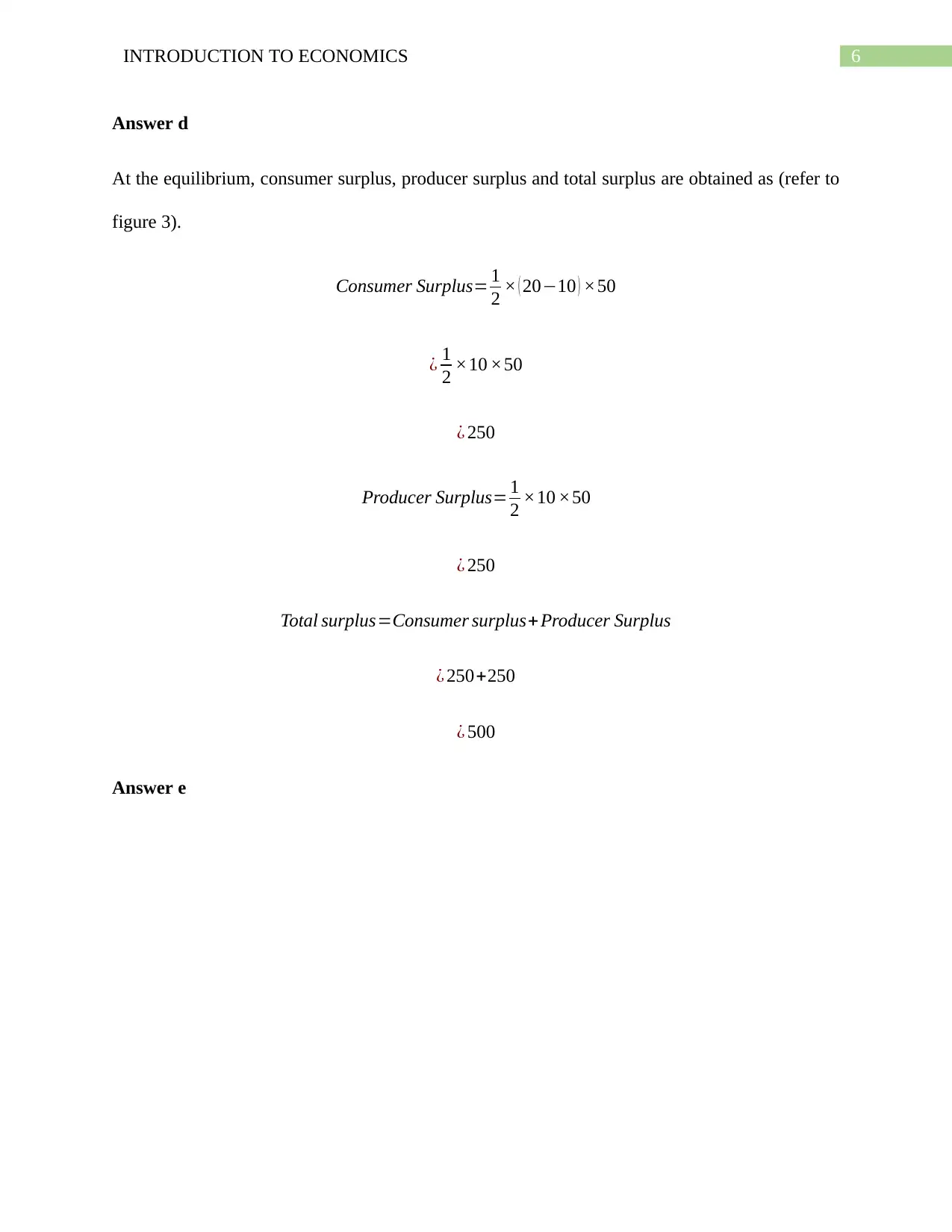
6INTRODUCTION TO ECONOMICS
Answer d
At the equilibrium, consumer surplus, producer surplus and total surplus are obtained as (refer to
figure 3).
Consumer Surplus= 1
2 × ( 20−10 ) ×50
¿ 1
2 ×10 ×50
¿ 250
Producer Surplus= 1
2 ×10 ×50
¿ 250
Total surplus=Consumer surplus+ Producer Surplus
¿ 250+250
¿ 500
Answer e
Answer d
At the equilibrium, consumer surplus, producer surplus and total surplus are obtained as (refer to
figure 3).
Consumer Surplus= 1
2 × ( 20−10 ) ×50
¿ 1
2 ×10 ×50
¿ 250
Producer Surplus= 1
2 ×10 ×50
¿ 250
Total surplus=Consumer surplus+ Producer Surplus
¿ 250+250
¿ 500
Answer e
Paraphrase This Document
Need a fresh take? Get an instant paraphrase of this document with our AI Paraphraser
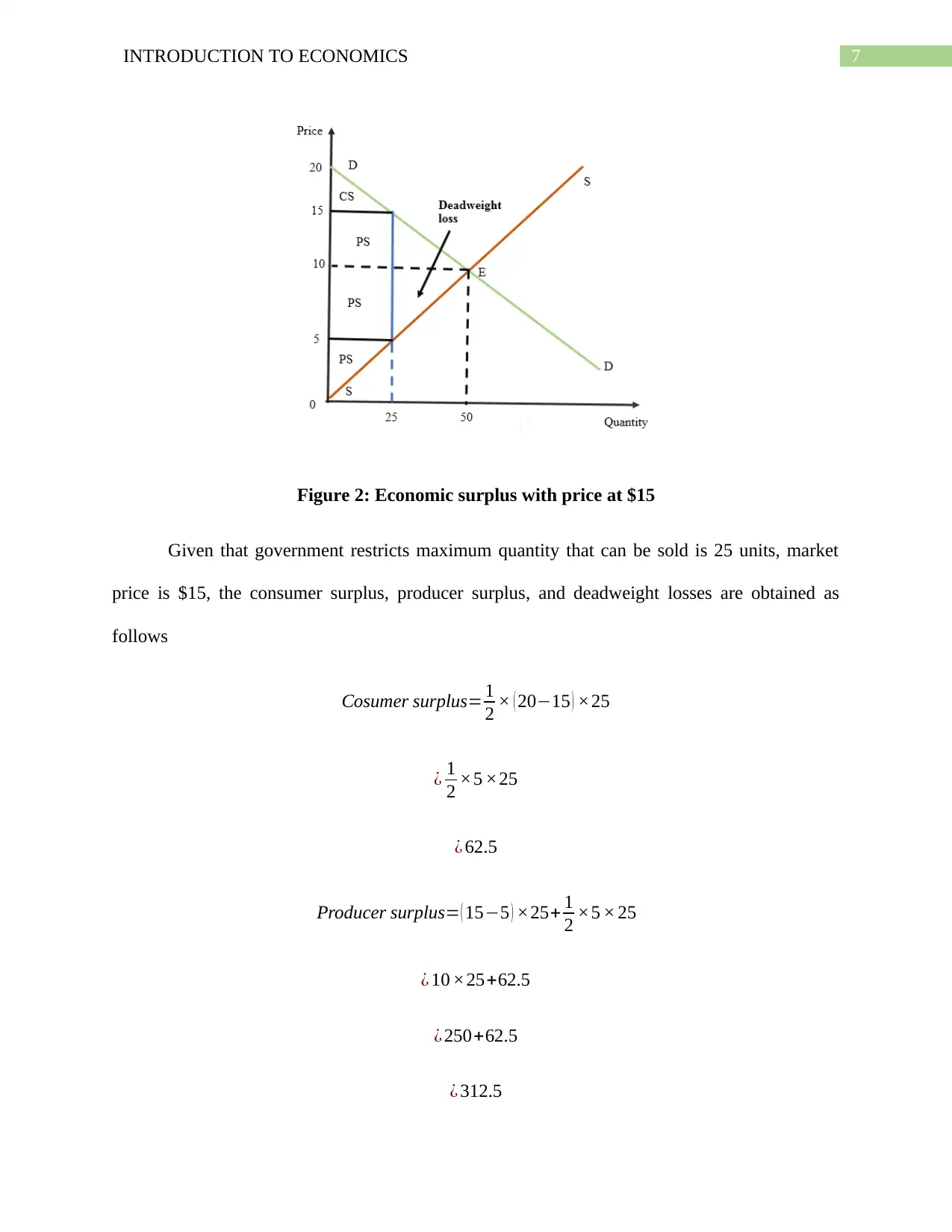
7INTRODUCTION TO ECONOMICS
Figure 2: Economic surplus with price at $15
Given that government restricts maximum quantity that can be sold is 25 units, market
price is $15, the consumer surplus, producer surplus, and deadweight losses are obtained as
follows
Cosumer surplus= 1
2 × ( 20−15 ) ×25
¿ 1
2 ×5 ×25
¿ 62.5
Producer surplus= ( 15−5 ) ×25+ 1
2 ×5 × 25
¿ 10 ×25+62.5
¿ 250+62.5
¿ 312.5
Figure 2: Economic surplus with price at $15
Given that government restricts maximum quantity that can be sold is 25 units, market
price is $15, the consumer surplus, producer surplus, and deadweight losses are obtained as
follows
Cosumer surplus= 1
2 × ( 20−15 ) ×25
¿ 1
2 ×5 ×25
¿ 62.5
Producer surplus= ( 15−5 ) ×25+ 1
2 ×5 × 25
¿ 10 ×25+62.5
¿ 250+62.5
¿ 312.5

8INTRODUCTION TO ECONOMICS
Deadweight loss=2 × ( 1
2 ×5 ×25 )
¿ 25 ×5
¿ 125
Figure 3: Economic surplus with price at $5
If the market price is $5, then the resulted consumer surplus, producer surplus and deadweight
loss are
Consumer surplus= ( 15−5 ) ×25+ 1
2 ×(20−15) ×25
¿ 10 ×25+ 1
2 ×5 × 25
¿ 250+62.5
¿ 312.5
Producer surplus= 1
2 ×5 × 25
Deadweight loss=2 × ( 1
2 ×5 ×25 )
¿ 25 ×5
¿ 125
Figure 3: Economic surplus with price at $5
If the market price is $5, then the resulted consumer surplus, producer surplus and deadweight
loss are
Consumer surplus= ( 15−5 ) ×25+ 1
2 ×(20−15) ×25
¿ 10 ×25+ 1
2 ×5 × 25
¿ 250+62.5
¿ 312.5
Producer surplus= 1
2 ×5 × 25
⊘ This is a preview!⊘
Do you want full access?
Subscribe today to unlock all pages.

Trusted by 1+ million students worldwide

9INTRODUCTION TO ECONOMICS
¿ 62.5
Deadweight loss=2 × ( 1
2 ×5 ×25 )
¿ 25 ×5
¿ 125
Answer f
Figure 4: Market equilibrium
Answer 3
Answer a
Introduction of online video rental and streaming are alternative to DVDs rented from in
store movie industry. Therefore, it has an obvious impact of reducing demand for in-store movie
industry. As demand declines, demand curve shifts inward lowering equilibrium price and
¿ 62.5
Deadweight loss=2 × ( 1
2 ×5 ×25 )
¿ 25 ×5
¿ 125
Answer f
Figure 4: Market equilibrium
Answer 3
Answer a
Introduction of online video rental and streaming are alternative to DVDs rented from in
store movie industry. Therefore, it has an obvious impact of reducing demand for in-store movie
industry. As demand declines, demand curve shifts inward lowering equilibrium price and
Paraphrase This Document
Need a fresh take? Get an instant paraphrase of this document with our AI Paraphraser
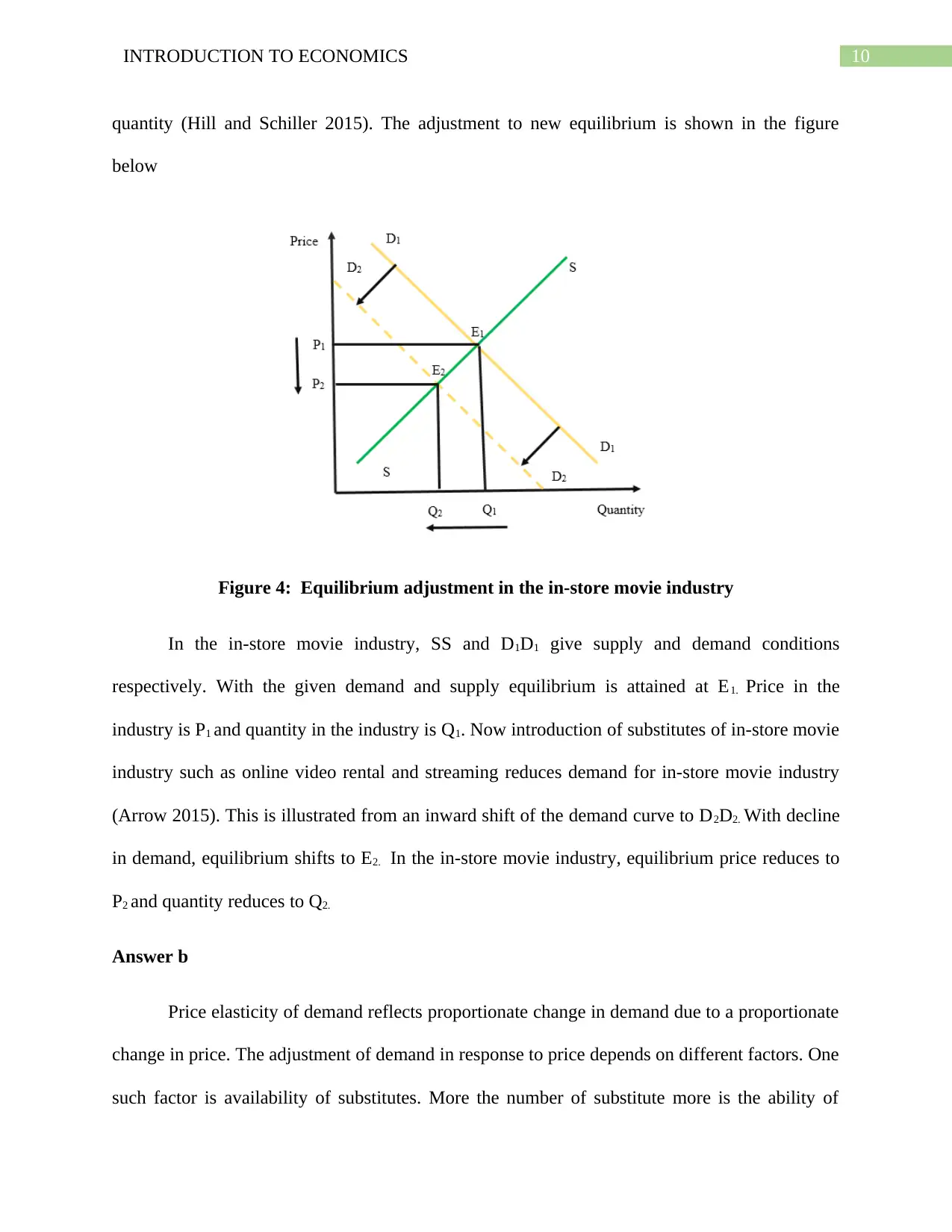
10INTRODUCTION TO ECONOMICS
quantity (Hill and Schiller 2015). The adjustment to new equilibrium is shown in the figure
below
Figure 4: Equilibrium adjustment in the in-store movie industry
In the in-store movie industry, SS and D1D1 give supply and demand conditions
respectively. With the given demand and supply equilibrium is attained at E1. Price in the
industry is P1 and quantity in the industry is Q1. Now introduction of substitutes of in-store movie
industry such as online video rental and streaming reduces demand for in-store movie industry
(Arrow 2015). This is illustrated from an inward shift of the demand curve to D2D2. With decline
in demand, equilibrium shifts to E2. In the in-store movie industry, equilibrium price reduces to
P2 and quantity reduces to Q2.
Answer b
Price elasticity of demand reflects proportionate change in demand due to a proportionate
change in price. The adjustment of demand in response to price depends on different factors. One
such factor is availability of substitutes. More the number of substitute more is the ability of
quantity (Hill and Schiller 2015). The adjustment to new equilibrium is shown in the figure
below
Figure 4: Equilibrium adjustment in the in-store movie industry
In the in-store movie industry, SS and D1D1 give supply and demand conditions
respectively. With the given demand and supply equilibrium is attained at E1. Price in the
industry is P1 and quantity in the industry is Q1. Now introduction of substitutes of in-store movie
industry such as online video rental and streaming reduces demand for in-store movie industry
(Arrow 2015). This is illustrated from an inward shift of the demand curve to D2D2. With decline
in demand, equilibrium shifts to E2. In the in-store movie industry, equilibrium price reduces to
P2 and quantity reduces to Q2.
Answer b
Price elasticity of demand reflects proportionate change in demand due to a proportionate
change in price. The adjustment of demand in response to price depends on different factors. One
such factor is availability of substitutes. More the number of substitute more is the ability of
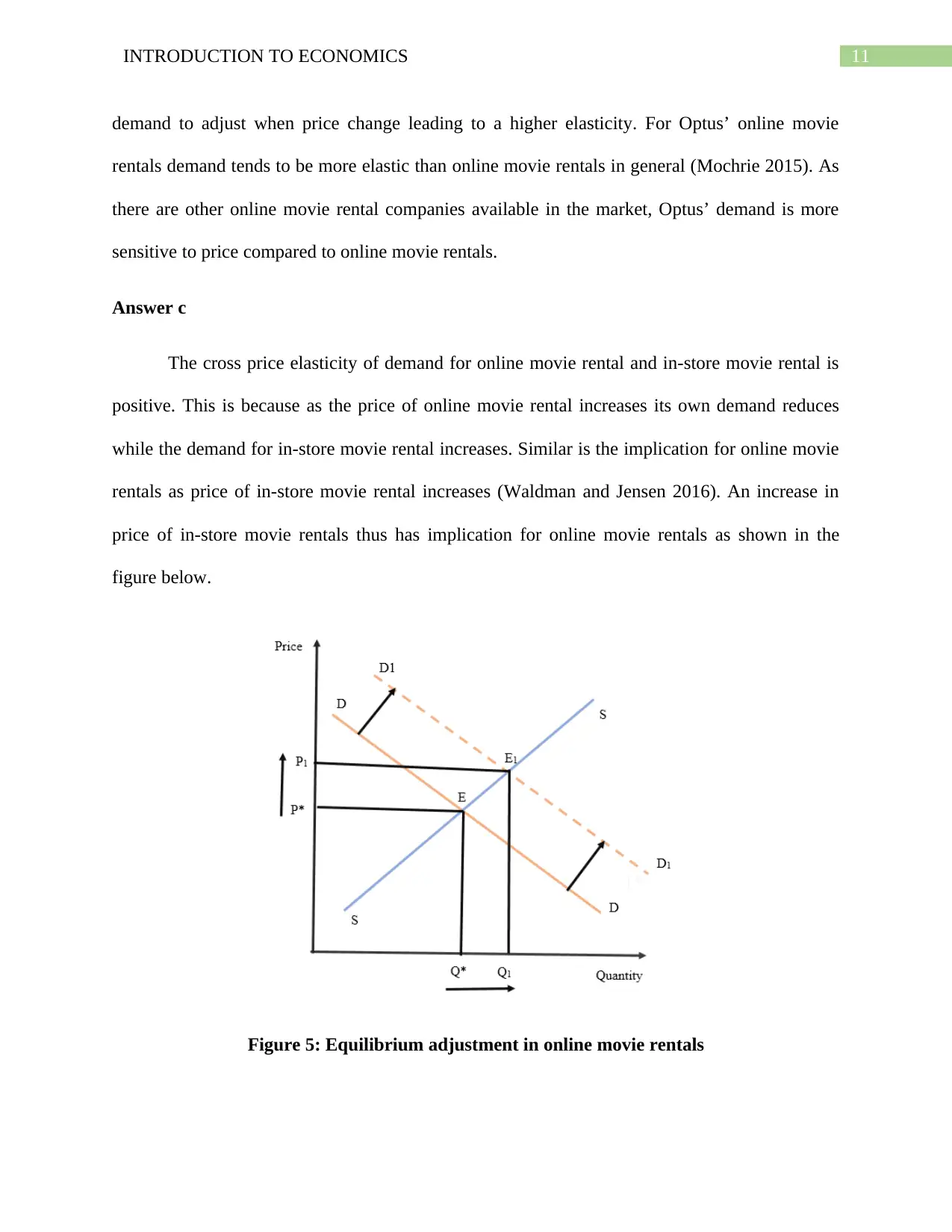
11INTRODUCTION TO ECONOMICS
demand to adjust when price change leading to a higher elasticity. For Optus’ online movie
rentals demand tends to be more elastic than online movie rentals in general (Mochrie 2015). As
there are other online movie rental companies available in the market, Optus’ demand is more
sensitive to price compared to online movie rentals.
Answer c
The cross price elasticity of demand for online movie rental and in-store movie rental is
positive. This is because as the price of online movie rental increases its own demand reduces
while the demand for in-store movie rental increases. Similar is the implication for online movie
rentals as price of in-store movie rental increases (Waldman and Jensen 2016). An increase in
price of in-store movie rentals thus has implication for online movie rentals as shown in the
figure below.
Figure 5: Equilibrium adjustment in online movie rentals
demand to adjust when price change leading to a higher elasticity. For Optus’ online movie
rentals demand tends to be more elastic than online movie rentals in general (Mochrie 2015). As
there are other online movie rental companies available in the market, Optus’ demand is more
sensitive to price compared to online movie rentals.
Answer c
The cross price elasticity of demand for online movie rental and in-store movie rental is
positive. This is because as the price of online movie rental increases its own demand reduces
while the demand for in-store movie rental increases. Similar is the implication for online movie
rentals as price of in-store movie rental increases (Waldman and Jensen 2016). An increase in
price of in-store movie rentals thus has implication for online movie rentals as shown in the
figure below.
Figure 5: Equilibrium adjustment in online movie rentals
⊘ This is a preview!⊘
Do you want full access?
Subscribe today to unlock all pages.

Trusted by 1+ million students worldwide
1 out of 14
Related Documents
Your All-in-One AI-Powered Toolkit for Academic Success.
+13062052269
info@desklib.com
Available 24*7 on WhatsApp / Email
![[object Object]](/_next/static/media/star-bottom.7253800d.svg)
Unlock your academic potential
Copyright © 2020–2025 A2Z Services. All Rights Reserved. Developed and managed by ZUCOL.





